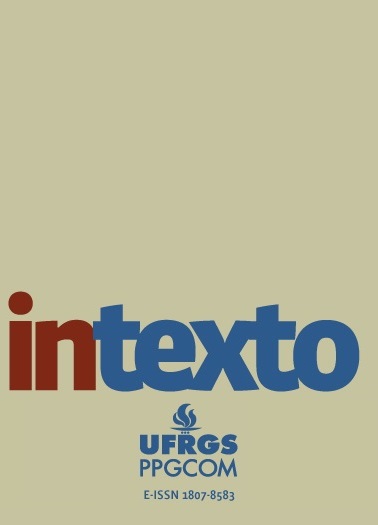The hedonist perspective of the femme fatale element: the contribution of visuality in building the Nelly Borden character in Milano Calibro 9
DOI:
https://doi.org/10.19132/1807-8583202152.107455Keywords:
Film analysis. Italian film noir. Art direction. Femme fatale. Hedonism.Abstract
This work aims, from the analysis of the movie Milano calibro 9, address the hedonistic perspective of Italian film noir. The element femme fatale is chosen as the central focus of observation. Priority is given to the visuality of the work, seeking more regularly the concrete and visible elements of art direction work. The analysis is conducted by a methodological construction understood from some assumptions of film analysis, highlighting the authors Jacques Aumont & Michel Marie, Francis Vanoye & Anne Goliot-Lété, and the methodological proposition of Diane Rose . This research allows us to point out and reflect on how the femme fatale, in its hedonistic potential, directs the other characters and works as a fundamental element for the conduction of the narrative.
Downloads
References
AUGUSTI, A. R. Cinema noir: as marcas da morte e do hedonismo na atualização do gênero. 2013. Tese (Doutorado em Comunicação Social) – Programa de Pós-Graduação em Comunicação Social, Pontifícia Universidade Católica do Rio Grande do Sul, Porto Alegre, 2013. Disponível em: https://tede2.pucrs.br/tede2/bitstream/tede/4520/1/TES_ALEXANDRE_ROSSATO_AUGUSTI_COMPLETO.pdf
AUMONT, J.; MARIE, M. A análise do filme. 2 ed., Lisboa: Texto e Grafia, 2004.
BAZIN, A. Le décor est un acteur. CinéClub, Fédération Française des Ciné-Clubs, n.
, déc. 1949. p. 6-7.
BORDE, R.; CHAUMETON, E. Panorama del cine negro. Buenos Aires: Losange, 1958.
CAPRARA, V.; COZZOLINO, G. Cinema noir e neonoir italianos. [Entrevista concedida a Alexandre Augusti]. Napoli, 19 jan. 2016.
CHEVALIER, J.; GHEERBRANT, A. Dicionário de símbolos: mitos, sonhos, costumes, gestos, formas, figuras, cores, números. Rio de Janeiro: José Olympio, 1992.
FREZZA, L. Cinema noir e neonoir. [Entrevista concedida a Alexandre Augusti]. Fisciano, 16 maio. 2012.
HEREDERO, C. F.; SANTAMARINA, A. El cine negro: maduración y crisis de la escritura clásica. Barcelona: Paidós, 1996.
JACOB, E. M. Um lugar para ser visto: a direção de arte e a construção da paisagem no cinema. 2006. Dissertação (Mestrado em Comunicação, Imagem e Informação) – Curso de Pós-Graduação em Comunicação, Imagem e Informação, Universidade Federal Fluminense, Niterói, 2006.
JUNQUEIRA, T. Direção de arte em cinema: leituras de um espaço. In: BUTRUCE, D; BOUILLET, R. (org.). A direção de arte no cinema brasileiro. Rio de Janeiro: Caixa Cultural, 2017. p. 150-159.
LE JOUR se lève. Direção: Marcel Carné. Produção: Jean-Pierre Frogerais. Intérpretes: Jean Gabin, Jules Berry, Arletty et al. Roteiro: Jacques Viot, Jacques Prévert et al. [S.l.]: Productions Sigma. France, 1939, DVD (93 min), son., preto e branco. Título em português: Trágico amanhecer.
MATTOS, A. C. de G. de. O outro lado da noite: film noir. Rio de Janeiro: Rocco, 2001.
MILANO calibro 9. Direção: Fernando di Leo. Produção: Armando Novelli. Intérpretes: Gastone Moschin; Barbara Bouchet; Mario Adorf et al. Roteiro: Fernando di Leo. [S. l.]: Cineproduzioni Daunia 70. Italia, 1972, DVD (100 min), son., color.
ROSE, D. Análise de imagens em movimento. In: BAUER, M, W.; GASKELL, D. (org.). Pesquisa qualitativa com texto, imagem e som: um manual prático. 2. ed. Petrópolis, Vozes, 2002. p. 343-363.
SEGER, L. Como criar personagens inesquecíveis. São Paulo: Bossa Nova, 2006.
SILVER, A.; URSINI, J. Film noir. Lisboa: Taschen, 2004.
VANOYE, F.; GOLIOT-LÉTÉ, A. Ensaio sobre a análise fílmica. 6. ed. Campinas: Papirus, 1994.
VARGAS, G. P. Direção de arte: um estudo sobre sua contribuição na construção dos personagens Lígia, Kika e Wellington do filme Amarelo Manga. 2014. Dissertação (Mestrado em Comunicação Social) – Programa de Pós-Graduação da Faculdade de Comunicação Social, Pontifícia Universidade Católica do Rio Grande do Sul, Porto Alegre, 2014.
ŽIŽEK, S. Lacrimae rerum: ensaios sobre cinema moderno. São Paulo: Boitempo, 2009.
Downloads
Published
How to Cite
Issue
Section
License
Copyright (c) 2021 Alexandre Rossato Augusti, Gilka Padilha de Vargas

This work is licensed under a Creative Commons Attribution-NonCommercial 4.0 International License.
The copyright of works published in this journal belong to the authors, and the right of first publication is conceded to the journal. Due to the journal being of open access, the articles are of free use in research, educational and non-commercial activities.
Therefore, the journal uses the License Creative Commons Attribution (CC BY-NC 4.0), which allows sharing of work with acknowledgment of authorship.
Self-archiving (repository policy): authors are allowed to deposit all versions of their work in institutional or thematic repositories without embargo. It is requested, whenever possible, that the full bibliographic reference of the version published in Intexto (including the DOI link) be added to the archived text.
Intexto does not charge any article processing fees (article processing charge).















